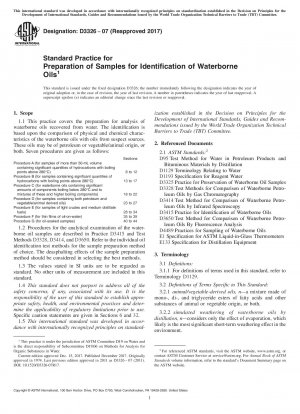ASTM D3326-07(2017)
Standard Practice for Preparation of Samples for Identification of Waterborne Oils
- Standard No.
- ASTM D3326-07(2017)
- Release Date
- 2017
- Published By
- American Society for Testing and Materials (ASTM)
- Latest
- ASTM D3326-07(2017)
- Scope
- 1.1 This practice covers the preparation for analysis of waterborne oils recovered from water. The identification is based upon the comparison of physical and chemical characteristics of the waterborne oils with oils from suspect sources. These oils may be of petroleum or vegetable/animal origin, or both. Seven procedures are given as follows: Sections Procedure A (for samples of more than 50-mL volume containing significant quantities of hydrocarbons with boiling points above 280°C) 8 to 12 Procedure B (for samples containing significant quantities of hydrocarbons with boiling points above 280°C) 13 to 17 Procedure C (for waterborne oils containing significant amounts of components boiling below 280°C and to mixtures of these and higher boiling components) 18 to 22 Procedure D (for samples containing both petroleum and vegetable/animal derived oils) 23 to 27 Procedure E (for samples of light crudes and medium distillate fuels) 28 to 34 Procedure F (for thin films of oil-on-water) 35 to 39 Procedure G (for oil-soaked samples) 40 to 44 1.2 Procedures for the analytical examination of the waterborne oil samples are described in Practice D3415 and Test Methods D3328, D3414, and D3650. Refer to the individual oil identification test methods for the sample preparation method of choice. The deasphalting effects of the sample preparation method should be considered in selecting the best methods. 1.3 The values stated in SI units are to be regarded as standard. No other units of measurement are included in this standard. 1.4 This standard does not purport to address all of the safety concerns, if any, associated with its use. It is the responsibility of the user of this standard to establish appropriate safety, health, and environmental practices and determine the applicability of regulatory limitations prior to use. Specific caution statements are given in Sections 6 and 32. 1.5 This international standard was developed in accordance with internationally recognized principles on standardization established in the Decision on Principles for the Development of International Standards, Guides and Recommendations issued by the World Trade Organization Technical Barriers to Trade (TBT) Committee.
ASTM D3326-07(2017) Referenced Document
- ASTM D1129 Standard Terminology Relating to Water
- ASTM D1193 Standard Specification for Reagent Water
- ASTM D3325 Standard Practice for Preservation of Waterborne Oil Samples*, 2020-01-01 Update
- ASTM D3328 Standard Test Methods for Comparison of Waterborne Petroleum Oils by Gas Chromatography*, 2020-01-01 Update
- ASTM D3414 Standard Test Method for Comparison of Waterborne Petroleum Oils by Infrared Spectroscopy
- ASTM D3415 Standard Practice for Identification of Waterborne Oils
- ASTM D3650 Standard Test Method for Comparison of Waterborne Petroleum Oils By Fluorescence Analysis
- ASTM D4489 Standard Practices for Sampling of Waterborne Oils
- ASTM D95 Standard Test Method for Water in Petroleum Products and Bituminous Materials by Distillation
- ASTM E1 Standard Specification for ASTM Thermometers
- ASTM E133 Standard Specification for Distillation Equipment*, 2022-01-01 Update
ASTM D3326-07(2017) history
- 2017 ASTM D3326-07(2017) Standard Practice for Preparation of Samples for Identification of Waterborne Oils
- 2007 ASTM D3326-07(2011) Standard Practice for Preparation of Samples for Identification of Waterborne Oils
- 2007 ASTM D3326-07 Standard Practice for Preparation of Samples for Identification of Waterborne Oils
- 1990 ASTM D3326-90(2002) Standard Practice for Preparation of Samples for Identification of Waterborne Oils
- 1996 ASTM D3326-90(1996)e1 Standard Practice for Preparation of Samples for Identification of Waterborne Oils
- 1990 ASTM D3326-90(1996) Standard Practice for Preparation of Samples for Identification of Waterborne Oils
